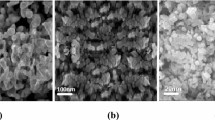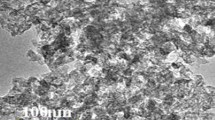Abstract
Experimental investigation on the heat transfer characteristics of the nanofluids passing through mini hexagonal tube heat sink (MHTHS) was accomplished. Al2O3–EG, CuO–EG, and SiO2–EG nanofluids with volume fraction ranging from 0.01 to 0.04% were chosen in the present study. The dispersion of nanoparticles in ethylene glycol (EG) was used as the working fluids. The volume flow rate of nanofluids flow through the hexagonal tube side was varied from 15 to 50 L h−1, and the hot deionized water in mini passage side was kept constant at a volume flow rate of 30 L h−1. The heat transfer characteristics of nanofluids were studied with the concentration of nanoparticles in base fluid and effect of Reynolds number. The heat transfer coefficient of MHTHS was measured under fully developed laminar and turbulent flow conditions. Based on the experimental data, it was observed that thermal conductivity, heat transfer coefficient, and Nusselt number of CuO–EG nanofluid were found to be higher when compared to other two nanofluids. The thermal conductivity of nanofluids was enhanced with an increase in concentration of nanoparticles in EG. The enhancement in heat transfer coefficient of nanofluid was achieved at higher turbulence in turbulent flow. It was due to stable dispersion of nanoparticles in EG. Therefore, the enhancement in heat transfer coefficient was found to be 36%, 32%, and 22% for CuO–EG, Al2O3–EG, and SiO2–EG nanofluid, respectively, at the concentration of 0.04 vol%. At higher Reynolds number, the agglomeration of nanoparticles decreases. Hence, it caused a decrease in boundary layer thickness which leads to an increase in the heat transfer-enhanced Nusselt number. The friction factor of SiO2–EG nanofluid was found to be lower in turbulent flow regime, and furthermore, it had no substantial effect in laminar flow regime.







Similar content being viewed by others
References
Choi SUS. Enhancing thermal conductivity of fluids with nanoparticle. ASME FED. 1995;231:99–105.
Chen H, Witharana S, Yi Jin, Kim C, Ding Y. Predicting thermal conductivity of liquid suspensions of nanoparticles (nanofluid) based on rheology. Particuology. 2009;7:151–7.
Xiong Q, Tlili I, Dara RN, Shafee A, Nguyen-Thoi T, Rebey A, Li Z. Energy storage simulation involving NEPCM solidification in appearance of fins. Phys A Stat Mech Appl. 2020;544:123–566.
Murshed S, Leong K, Yang C. Investigations of thermal conductivity and viscosity of nanofluid. Int J Therm Sci. 2008;47:560–8.
Leong KC, Yang C, Murshed SMS. A model for the thermal conductivity of nanofluid the effect of interfacial layer. J Nanopart Res. 2006;8:245–54.
Kumar N, Sonawane SS. Experimental study of Fe2O3/water andFe2O3/ethylene glycol nanofluid heat transfer enhancement in a shell and tube heat exchanger. Int J Commun Heat Mass Transf. 2016;78:277–84.
Elias MM, Mahbubul IM, Saidur R, Sohel MR, Shahrul IM, Khaleduzzaman SS, Sadeghipour S. Experimental investigation on the thermo physical properties of Al2O3 nanoparticles suspended in car radiator coolant. Int Commun Heat Mass Transf. 2014;54:48–53.
Vajjha RS, Das DK. A review and analysis on influence of temperature and concentration of nanofluid on thermo physical properties, heat transfer and pumping power. Int J Heat Mass Transf. 2012;55:4063–78.
Mahbubul IM, Shahrul IM, Khaleduzzaman SS, Saidur RR, Amalina MA, Turgut A. Experimental investigation on effect of ultrasonication duration on colloidal dispersion and thermo physical properties of alumina–water nanofluid. Int J Heat Mass Transf. 2015;88:73–81.
Haddad Z, Abid C, Oztop HF, Mataoui A. A review on how the researchers prepare their nanofluid. Int J Therm Sci. 2014;76:168–89.
Weerapun D, Wongwises S. Measurement of temperature-dependent thermal conductivity and viscosity of TiO2–water nanofluid. Exp Therm Fluid Sci. 2009;33:706–14.
He Q, Wang S, Tong M, Liu Y. Experimental study on thermo physical properties of nanofluid as phase-change material (PCM) in low temperature cool storage. Energy Convers Manag. 2012;64:199–205.
Starace AK, Gomez JC, Wang J, Pradhan S, Glatzmaier GC. Nanofluid heat capacities. J Appl Phys. 2011;110:124–323.
Shahrul IM, Mahbubul IM, Khaleduzzaman SS, Saidur R, Sabri MFM. A comparative review on the specific heat of nanofluid for energy perspective. Renew Sustain Energy Rev. 2014;38:88–98.
Shin D, Banerjee D. Enhancement of specific heat capacity of high temperature silica nanofluid synthesized in alkali chloride salt eutectics for solar thermal-energy storage applications. Int J Heat Mass Transf. 2011;54:1064–70.
Selimefendigil F, Öztop HF. Identification of forced convection in pulsating flow at a backward facing step with a stationary cylinder subjected to nanofluid. Int Commun Heat Mass Transf. 2013;45:111–21.
Pastoriza-Gallego MJ, Lugo L, Legido JL, Pineiro MM. Thermal conductivity and viscosity measurements of ethylene glycol-based Al2O3 nanofluid. Nanoscale Res Lett. 2011;6:221–5.
Khedkar RS, Shrivastava N, Sonawane SS, Wasewar KL. Experimental investigations and theoretical determination of thermal conductivity and viscosity of TiO2–ethylene glycol nanofluid. Int Commun Heat Mass Transf. 2016;73:54–61.
Maddah H, Alizadeh M, Ghasemi N, Alwi SRW. Experimental study of Al2O3/water nanofluid turbulent heat transfer enhancement in the horizontal double pipes fitted with modified twisted tapes. Int J Heat Mass Transf. 2014;78:1042–54.
Wang XQ, Mujumdar AS. Heat transfer characteristics of nanofluid: a review. Int J Therm Sci. 2007;46:1–19.
Kumar N, Shriram SS. Experimental study of thermal conductivity and convective heat transfer enhancement using CuO and TiO2 nanoparticles. Int Commun Heat Mass Transf. 2016;76:98–107.
Durga Prasad PV, Gupta AVS, Gupta SKS. Experimental investigation on enhancement of heat transfer using Al2O3/water nanofluid in a u-tube with twisted tape inserts. Int Commun Heat Mass Transf. 2016;75:154–61.
Radkar RN, Bhanvase BA, Barai DP, Sonawane SH. Intensified convective heat transfer using ZnO nanofluid in heat exchanger with helical coiled geometry at constant wall temperature. Mater Sci Energy Technol. 2019;2:161–70.
Bondarenko DS, Sheremet MA, Oztop HF, Ali ME. Natural convection of Al2O3/H2O nanofluid in a cavity with a heat-generating element Heatline visualization. Int J Heat Mass Transf. 2019;130:564–74.
Abu-Nada E, Oztop HF. Numerical analysis of Al2O3/water nanofluid natural convection in a wavy walled cavity. Numer Heat Transf Part A Appl. 2011;59:403–19.
Rimbault B, Nguyen CT, Galanis N. Experimental investigation of CuO–Water nanofluid flow and heat transfer inside a microchannel heat sink. Int J Therm Sci. 2014;84:275–92.
Harikrishnan S, Roseline AA, Kalaiselvam S. Preparation and thermo physical properties of water–glycerol mixture-based CuO nanofluid as PCM for cooling applications. IEEE Trans Nanotechnol. 2013;12:629–35.
Ahmadi S, Ali JA, Hamad SM, Shafee A, Ayani M, Nguyen-Thoi T. Modeling of heat transfer augmentation due to complex-shaped turbulator using nanofluid. Phys A Stat Mech Appl. 2020;540:122465.
Xiong Q, Jafaryar M, Divsalar A, Sheikholeslami M, Shafee A, Li Z. Macroscopic simulation of nanofluid turbulent flow due to compound turbulator in a pipe. Chem Phys. 2019;527:110475.
Azmia VK, Hamid A, Usri NA, Mamat R, Mohamad MS. Heat transfer and friction factor of water and ethylene glycol mixture based TiO2 and Al2O3 nanofluid under turbulent flow. Int Commun Heat Mass Transf. 2016;76:24–32.
Mahbubul IM, Chong TH, Khaleduzzaman SS, Shahrul IM, Saidur R, Long BD, Amalina MA. Effect of ultrasonication duration on colloidal structure and viscosity of alumina–water nanofluid. Ind Eng Chem Res. 2014;53:6677–84.
Harikrishnan S, Deepak K, Kalaiselvam S. Thermal energy storage behavior of composite using hybrid nanomaterials as PCM for solar heating systems. J Therm Anal Calorim. 2014;115:1563–71.
Kwak K, Kim C. Viscosity of thermal conductivity of copper oxide nanofluid dispersed in ethylene glycol. Korea Aust Rheol J. 2005;17:35–40.
Xiong Q, Vaseghi M, Ali JA, Hamad SM, Jafaryar M, Sheikholeslami M, Li Z. Nanoparticle application for heat transfer and irreversibility analysis in an air conditioning unit. J Mol Liq. 2019;292:1–11.
Kole M, Dey TK. Investigations on the pool boiling heat transfer and critical heat flux of ZnO-ethylene glycol nanofluid. Appl Therm Eng. 2012;37:112–9.
Maiga SEB, Palm SJ, Nguyen CT, Roy G, Galanis N. Heat transfer enhancement by using nanofluids in forced convection flows. Int J Heat Fluid Flow. 2005;26:530–46.
Fani B, Abbassi A, Kalteh M. Investigating the effect of Brownian motion and viscous dissipation on the nanofluid heat transfers in a trapezoidal micro channel heat sink. Adv Powder Technol. 2014;26:83–90.
Peyghambarzadeh SM, Hashemabadi SH, Hoseini SM, Seifi Jamnani M. Experimental study of heat transfer enhancement using water/ethylene glycol based nanofluid as a new coolant for car radiators. Int Commun Heat Mass Transf. 2011;38:1283–90.
Kumar N, Sonawane SS, Sonawane SH. Experimental study of thermal conductivity, heat transfer and friction factor of Al2O3 based nanofluid. Int Commun Heat Mass Transf. 2018;90:1–10.
Author information
Authors and Affiliations
Corresponding authors
Additional information
Publisher's Note
Springer Nature remains neutral with regard to jurisdictional claims in published maps and institutional affiliations.
Rights and permissions
About this article
Cite this article
Sriharan, G., Harikrishnan, S., Kalaiselvam, S. et al. Experimental investigation on the heat transfer performance of MHTHS using ethylene glycol-based nanofluids. J Therm Anal Calorim 143, 61–71 (2021). https://doi.org/10.1007/s10973-020-09764-y
Received:
Accepted:
Published:
Issue Date:
DOI: https://doi.org/10.1007/s10973-020-09764-y




